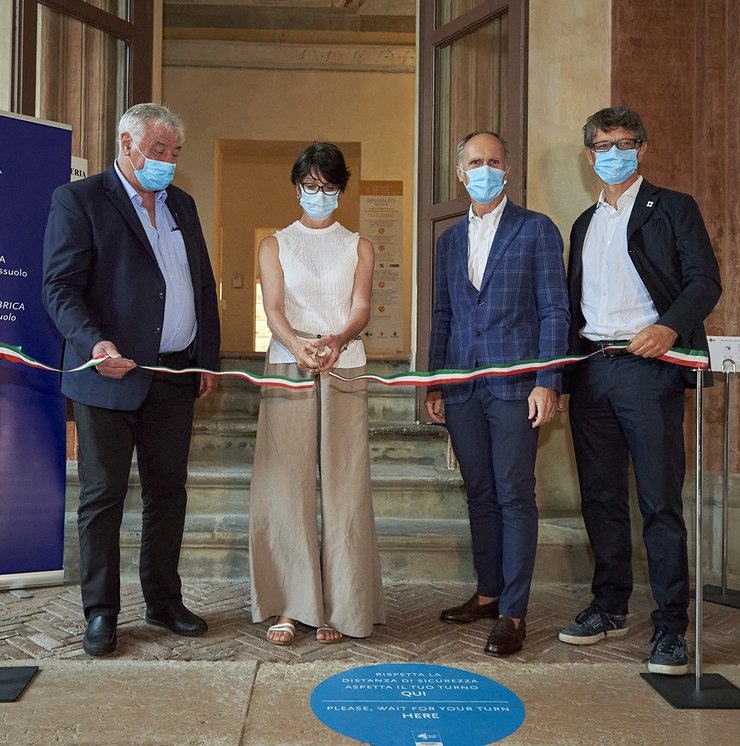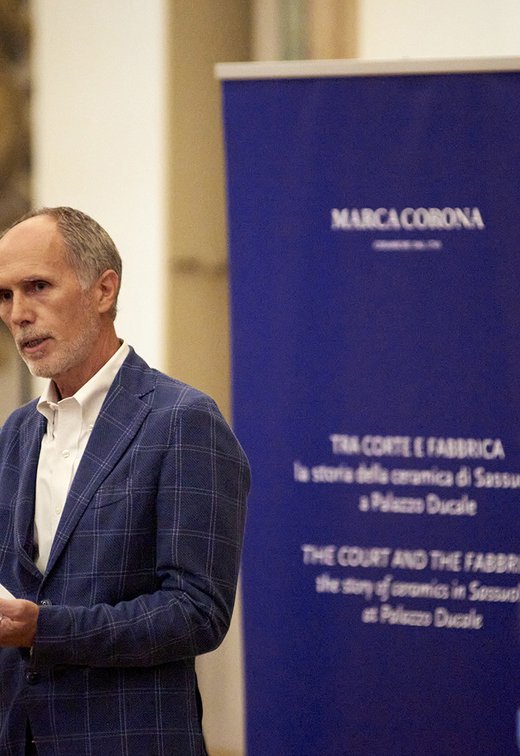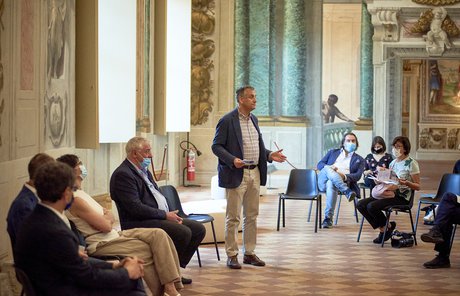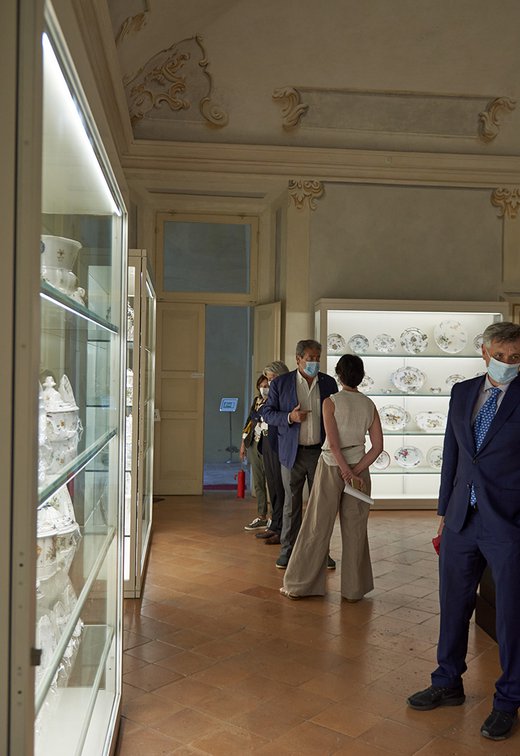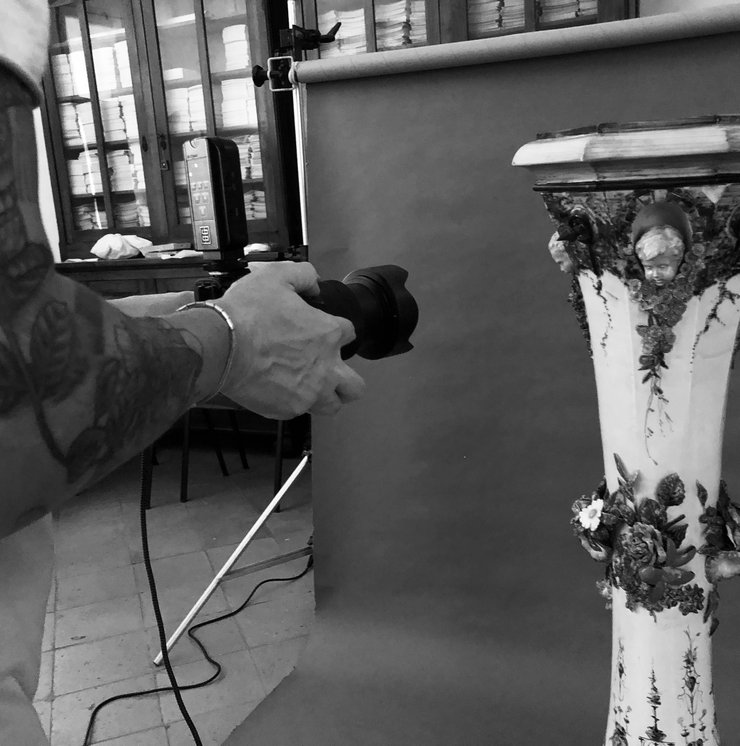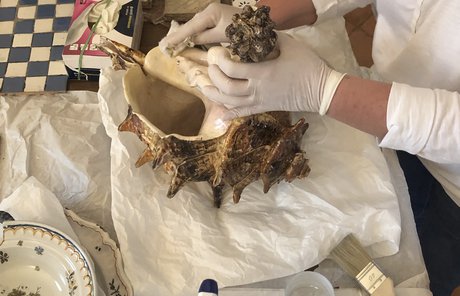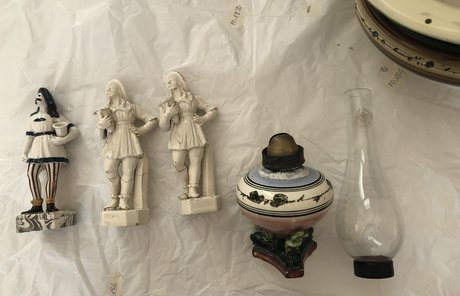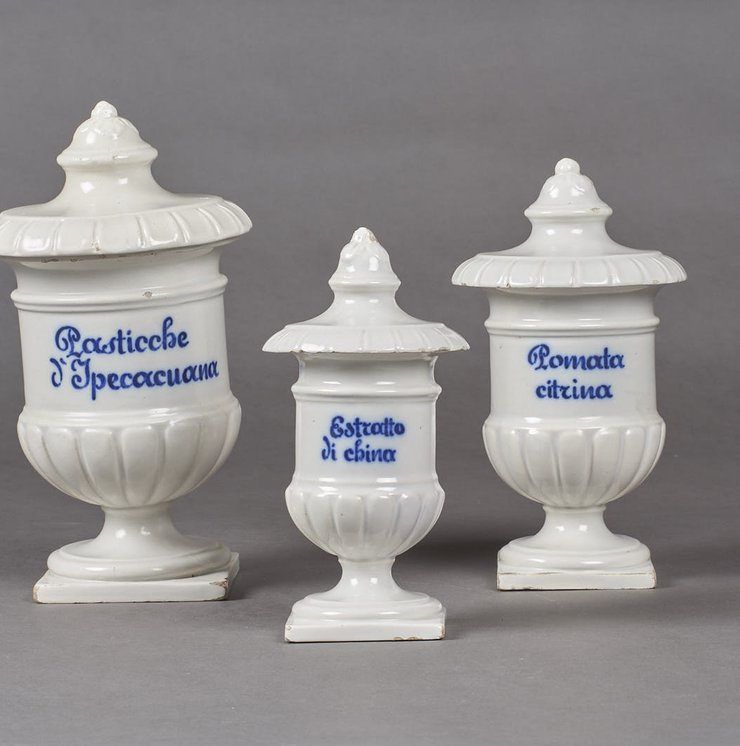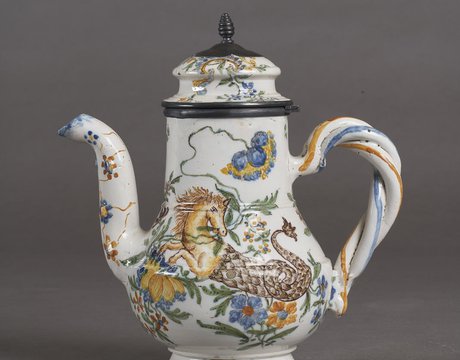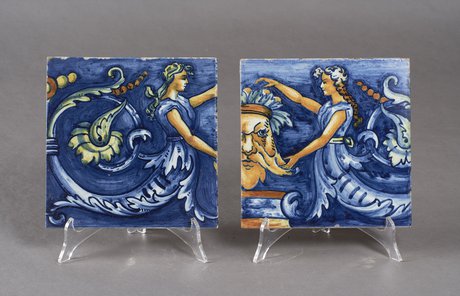Villa Vigarani Guastalla Collection
For the first time ever, Ceramiche Marca Corona is exhibiting more than 250 unique pieces from the Villa Vigarani Guastalla collection to the greater public.
Marca Corona is proud to present Between Court and Factory: the story of Sassuolo ceramic, the permanent exhibition dedicated to the Villa Vigarani Guastalla collection, promoted in partnership with Gallerie Estensi in Modena, and hosted at the Doge's Palace in Sassuolo. From 24th July 2020, the day of the official inauguration, and for the next 5 years, the precious Exhibition will be accessible free of charge to the citizens of Sassuolo and all international visitors wishing to retrace the evolution of ceramic production in the district and the story of Marca Corona, from 1741 until the turn of the 20th Century.
The acquisition of the Villa Vigarani Guastalla collection by Marca Corona is the result of the desire to enhance the value of Sassuolo’s ceramic heritage, a commitment already undertaken with the inauguration of the “Marca Corona Gallery” Company Museum in 2010, and strengthened by the constant local ceramic culture promotional activities.
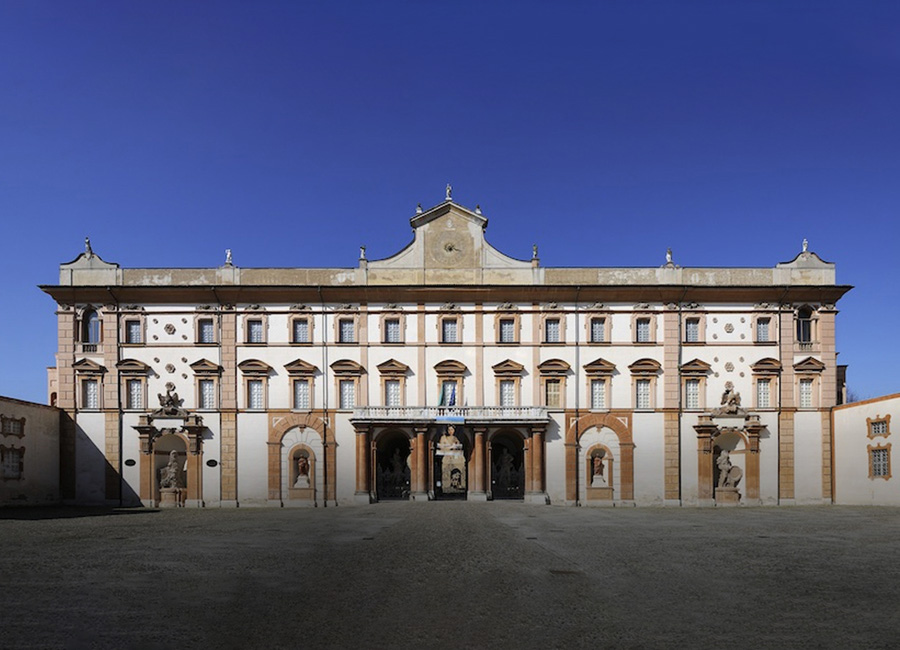

Exhibition rooms dedicated to the Exhibition "Between Court and Factory" at the Doge’s Palace in Sassuolo
The collection on exhibit in the Doge’s Palace, resulting from the pioneering spirit of the ceramic tile entrepreneur and collector Villiam Tioli and the contribution of the scholar Francesco Liverani, includes unique, high-value pieces, which represent the local majolica production, spearheaded by Marca Corona. With this artistic acquisition, Marca Corona was able to pool together a large number of pieces belonging to its own history, which now supplement the collection of objects housed inside the Company Museum, thereby creating an ideal journey between Court and Factory and providing a comprehensive overview of the history of the ceramic tile district, and of the Marca Corona brand.
Opening of the "Between Court and Factory" Exhibition
24 July 2020
“The dual journey Between Court and Factory allows the public to get an in-depth and comprehensive view of the history of our district, combining a corporate genetic heritage with a private collection which represents the local production. Our late chairman Professor Cirillo Mussini, promoter of the Company Museum which was dedicated to him, would be proud of this initiative which enriches the historic value of our collection and further strengthens the partnership between Marca Corona and the local territory” declared Lelio Poncemi, Managing Director of Ceramiche Marca Corona, who attended the Inauguration event that took place on 24th July 2020 in the presence of Local Authorities.
The exhibition consists of over 250 unique pieces, created between the middle of the 18th Century and the early 20th Century by the finest craftsmen in Sassuolo and the surrounding area. Within the exhibition, these relics have become genuine narrative objects, told through the words of the characters of the time and compared with everyday objects, in a constant dialogue between past and present, to discover the stories of ceramic in the local territory.

Room 1: Il Dallari

Room 1: Il Dallari
Hello and welcome!
Museums aren’t just places for contemplating beauty; they also explain life and embody history.
That’s certainly true of this collection of 250 objects, which tells the story of the white and decorated ceramics produced in the Sassuolo area in the eighteenth century.
As you move through the rooms, you’ll see thirteen display-cases filled with precious objects. These reveal the stylistic and technological developments of the first manufactory to be founded in Sassuolo.
Established in 1741, this public company was made up of members of the bourgeoisie and nobility, with the strong support of Duke Francesco III d'Este. At this time, the Duke was also pushing forward his restoration of this residence; expanding the large park and also renovating the town of Sassuolo. The manufactory later passed to the Dallari family who, after three generations, sold it to Count Ferrari Moreni. During the years of the Unification, the firm was sold to the Rubbiani family, who moved production away from artistic pieces towards a more industrial output. In fact, the Rubbiani were among the first, if not the first in Italy, to produce ceramic products for cladding and paving.
After passing the large entrance hall that overlooks the Court of Honour, you’ll find yourself in what was, in the mid-eighteenth century, part of the State Apartments of the Crown Prince, later Duke, Ercole Rinaldo III d’Este. That’s where our journey begins.
Room 1: Il Dallari
Display Case 1
Let’s begin with the half-bowl dating from the 13th century on the upper shelf. It’s an example of ‘poor’ terracotta, typically made by master potters, also known as boccolari.
These simply produced objects emerged when quality items began arriving in Sassuolo. Produced elsewhere, they’re characterised by the heraldic shields and geometric, floral and animal-based decorations, all scratched with a stick and decorated by brush using metal oxides.
There was a move away from this type of object under Francesco III d’Este, Duke of Modena, Reggio and Mirandola. In the mid-eighteenth century, he granted a group of individuals from Sassuolo the exclusive rights to produce ‘ordinary white and painted Majolica’. Before long, the company was sold to Giovanni Maria Dallari. A practical man, Dallari introduced new ways of speeding up production, and employed workers from Imola, Faenza and Lodi who knew ‘the special secret of white and glazes ...".
Among the best, most successful items produced by the Dallari manufactory were the monochrome pieces.
The variety of the Dallari range can be seen in the platters with elegant handles shaped like fins, the knife holders, serving plates, tureens and bottle coolers.
At the centre is a very important item: a fragment of a chimney piece from the 1770s. To find out more about its history… COURT MANUFACTORY
The decoration of ceramics has its own history, shaped by fashions and patterns that were introduced by itinerant painters who arrived in Sassuolo like meteors.
In this display case, you’ll find some of the shapes mentioned in the Dallari catalogue, alongside ‘twice fired’ ceramics and the decorative motifs known as: ‘of the little bird’ and ‘bouquet with drooping flowering stems’.
Display Case 2
As the years passed, production improved, and the manufactory achieved great commercial results and artistic originality. Giovanni Maria Dallari called to his side his son Giovanni, who welcomed his friend, the painter Pietro Lei, who had recently returned from several years working in Pesaro, where he’d achieved fame. He also invited another great ceramicist – the Bologna-based Leopoldo Finck, who was originally from Vienna.
On the second shelf are examples of the decoration known as ‘French-style flowers’. There are similarities between this service and objects produced at the Levantino manufactory in Empoli. Little-known until a few years ago, this manufactory is today the subject of research and new attributions.
On the top shelves is another service with two tureens and an elegant bottle cooler. The latter has an exuberant purple motif known as: ‘flowers and leaves held by a ribbon’. To find out more… A GLASS OF WINE
Display Case 3
In the third display case, you’ll find more models and ornamental forms. The decoration best represented here is the one known as ‘flowers and rockery’, which is sometimes combined with full or half-length figures.
The pieces that stand out in particular are those attributed to Pietro Giraud, who was from Livorno. Examples of his elegant work include the ribbed platter, two large vases decorated with garlands and goats’ heads and the fish kettle especially. If you’d like to know the secrets behind this magnificent piece… WHEN BEAUTY IMITATES NATURE
The last shelf presents numerous plates, platters, small ‘trumpet’-style flowerpots, and white majolica bulb holders with the decoration known as: ‘flowering branches’ or ‘various flowers’.
Display Case 4
Pietro Lei’s return to Sassuolo - after finding fame as ‘first painter’ at Pesaro’s Casali and Callegari manufactory - ushered in new shapes and decorations. These include the ribbed plates decorated in the ‘ticchio’ or ‘ticchiolo’ style, displayed on the first shelf. This motif owes its name to the shoot of tendril that emerges from a rocky base and supports a climber with three open flowers – this is an ornamental theme, linked to the then-current fashion for majolica inspired by the East, especially Japan. It’s highly likely that Pietro Lei himself introduced this motif.
Other pieces attributed to him here are the two plates - one oval and an unusual size, on the first shelf
Also important is the platter with scalloped edges and fin-shaped handles, which forms part of the so-called ‘flowers and figure’ collection. This appears on the manufactory’s price list. To find out more… FLOWERS AND OTHER MARVELS
At the centre is one of the most beautiful dishes produced in Sassuolo. THE MOST BEAUTIFUL PLATTER IN THE KINGDOM
As with Pietro Lei, the arrival of Leopoldo Finck in Sassuolo in 1788 ushered in another period of change. He introduced the ‘small fire’ technique, also known as ‘third firing, which is explained in the ‘book of secrets’ now on show in the Marca Corona Gallery. The results can be seen in the beautiful series of elegant ceramics displayed on the top shelf.
Room 1: Il Dallari

COURT MANUFACTORY
Chimney piece, half majolica or faience covered with engobe and varnished, 1770s
(made by Fabbrica Dallari)
1753. An archival note records that 283 hand-painted pieces like this one were consigned for the chimney pieces of the Stuccoed Apartment in Sassuolo’s Ducal Palace.
They were produced by the ceramic manufactory run by Giovanni Maria Dallari. This was the dawn of the manufactory’s history, and Francesco III d’Este had just given Dallari the monopoly for producing ‘Majolica, both ordinary white and painted’ – a type of tile that enjoyed great success and was reproduced with variations for decades.
This, however, is not majolica but engobed and varnished terracotta. The surface was first covered with a clay-like layer and fired with the white engobe, after which a glaze or transparent glass coating was applied to protect the surface without altering the adornments and colouring. As well as reducing the porosity of the terracotta, this double coating made it possible to apply drawn or painted decorations thanks to the white ground of the engobe
Sala 1: Il Dallari
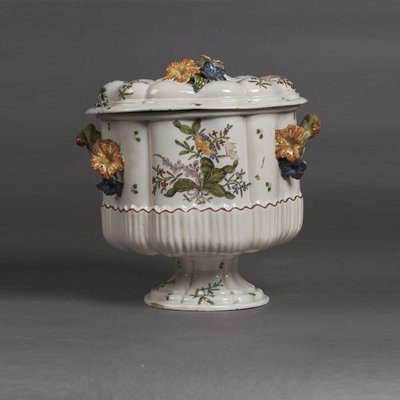
A GLASS OF WINE
Cooler for table bottle, majolica, second half of 18th century
(made by Fabbrica Dallari)
This cylindrical cooler with a lid and large base was modelled on the most refined examples of eighteenth-century silverware, like the dry-food and soup tureens alongside.
It is exuberantly decorated with a painted bouquet of flowers and leaves held together by a purple ribbon. The rich tonalities of the floral reliefs are astounding.
The cooler was placed on the table and filled with ice, snow or cold water into which a wine bottle was immersed. Coolers were usually shared between two guests.
This example is one of Giovanni Dallari’s best works. The son of the pioneer Giovanni Maria, Giovanni junior was a notary, a skilled ceramicist, a poet, a playwright and politician.
He sought to increase the cosmopolitan spirit of the manufactory by involving the great painter Pietro Lei and Leopoldo Finck, a ceramicist of Viennese origin.
The manufactory’s technical and artistic expertise thus evolved, making the quality of certain items timeless. This cooler is certainly one of the most important examples.
Sala 1: Il Dallari
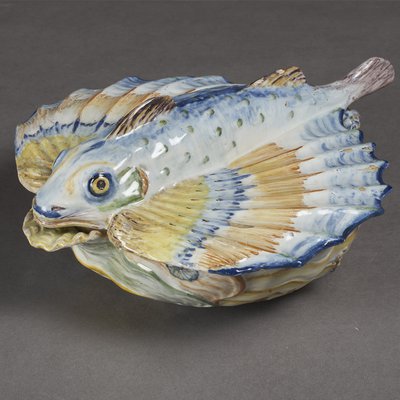
WHEN BEAUTY IMITATES NATURE
Fish tureen, majolica, 1860s
(made by Fabbrica Dallari)
What is wonder if not the capacity to spark a vivid and unexpected flash of admiration and surprise?
The eighteenth century celebrated the fashion, dating back to the Renaissance, of imitating the forms of nature in majolica.
Services were created that reproduced vegetables – pumpkins and cabbages – as well as animals – chickens, turkeys, pheasants, ducks, geese, wild boar heads, pigs and deer. Laying the table and dining became an experience of constant amazement.
This is exemplified by the tureen with a lid in the form of a gurnard fish, with fin-shaped handles and an oval body adorned with relief and painted motifs. It was probably made by the ‘famous sculptor’ from Livorno, Pietro Giraud, maybe of French origin.
Though he produced undeniably enchanting works, Giraud lived a life of restlessness. He worked in different manufactories, in Lodi, Naples, Faenza, Florence, before arriving in Sassuolo, in 1765, to teach the young apprentices. As had happened on other occasions, a few months after arriving, he escaped, to Nove di Bassano, this time also abandoning his wife.
His stay in the Sassuolo area was thus brief, but his style can be recognised in the dancing Chinese figures now in the Museo Civico d’Arte in Modena and in a private collection, and in the extraordinary centrepiece featuring Neptune for the Ducal Palace in Sassuolo, copied from Gian Lorenzo Bernini’s fountain, also in a private collection.
Room 1: Il Dallari

FLOWERS AND OTHER MARVELS
Dish, majolica, around 1780s
(made by Fabbrica Dallari)
Towards the end of the eighteenth century, Giovanni Maria Dallari called to his side his son Giovanni, who welcomed his friend Pietro Lei to the manufactory. Lei had found fame through his work as ‘first painter’ with the Callegari and Casali in Pesaro.
The quality of Lei’s work can be seen in this service of plates. Of particular note is the platter with a scalloped edge and ‘fin’ grips, which forms part of a ‘flowers and figures’ collection, a type also found on the manufactory’s price list.
The decorative details derive from different worlds, mostly imaginary. Half figures, knights, animals, cherubs, shepherds, nymphs, seahorses, mythological deities, and couples come to life on plates and pots of different shapes and sizes. They often stand at the centre of bouquets of multicoloured flowers – tulips, anemones, cornflowers, forget-me-nots, arnica.
The decorations were executed in two different ways: the flowers without outlines, known as ‘fine flowers’ were freely painted and the ‘outlined flowers and figures’ have contours painted with manganese brown.

THE MOST BEAUTIFUL PLATTER IN THE KINGDOM
Dish known as ‘Saxon-style’ with fox-shaped handles, majolica, after 1782
(made by Fabbrica Dallari)
Leopold Finck and his brother Joseph were originally from Vienna and later moved to Bologna. They are the protagonists of a ceramics production that flooded the market in the mid-eighteenth century and found great success among the upper rungs of local society.
But the two fell out and, in 1788 Leopoldo moved to Sassuolo to work for Giovanni Dallari. There, he shared with Dallari the secret of the paints used for firing in a ‘small fire’, better known as ‘third firing’. The process was described in the unique ‘book of secrets’ now on show in Galleria Marca Corona.
With the painter Pietro Lei, Finck set in motion a technological renewal at the Dallari manufactory. He also introduced new forms, such as the round plates on the last shelf of this display case.
Finck remained in Sassuolo for about a year, leaving works of notable quality. The rectangular platter with rounded corners and two fox-shaped handles was probably a collaboration between him and Pietro Lei.
The elegance of the forms and the decoration are astounding. The flowers, the so-called ‘crater’ rose, carnations and tulips, are all made in an identical way and can be attributed to Lei.
Room 2: The Earl Gio Ferrari and Giovanni Maria Rubbiani

Room 2: The Earl Gio Ferrari and Giovanni Maria Rubbiani
This room recounts the transformation of the Sassuolo manufactory’s management and production.
When Giovanni Maria Dallari died, the manufactory passed to his son Giovanni. However, in 1791, the ducal government revoked the exclusive rights it had granted Dallari to produce ceramics. What’s more, Pietro Lei founded his own manufactory. The adverse impact of this pushed the firm into crisis, which was worsened by the arrival of the French in 1796. The manufactory, now called ‘Vecchia’ or ‘Old, passed to the Dallari sons, Onorio, Odoardo and Costanzo, who carried on producing majolica but mostly earthenware. Production continued thanks to the presence of good educators and painters. However, with financial ups-and-downs, takeovers by new partners, the merging of the two manufactories, various rentals and subrentals, the picture became increasingly confused, and above all, precarious.
The return of the Austria-Este Archduke to Modena in 1815 gave Dallari hope that the old privileges would be restored, which they were but with many limitations
Room 2: The Earl Gio Ferrari and Giovanni Maria Rubbiani
Display Case 5
The objects in the first display case show how ceramic production retained a level of quality, despite the crisis. An example of this is the white majolica flower vase with a torchon hold and two handles shaped as lions’ heads.
Nonetheless, the manufactory’s accounts remained in the red and many workers moved to other factories, for example in Scandiano, taking their accumulated knowledge with them.
The autumn of 1835 saw further change: Count Giovanni Francesco Maria Ferrari Moreni bought the Vecchia manufactory, which was in trouble.
Ferrari Moreni showed great resourcefulness and flair in his artistic and production-related decisions. The manufactory refined formal aspects to meet the expectations of a very conservative society, which adopted tastes fashionable in the cities of the Habsburg Empire.
The count called in modellers and painters who had partly trained at Modena’s Academy of Fine Arts and proposed materials that recent studies have shown to be among the best in Italy. The same applies for glazes, in particular white, which, due to the high quality of the lead, achieved a brightness that made it famous.
The small elliptical tray from the second quarter of the nineteenth century is an example of this. THE LIGHT OF WHITE
Display Case 6
The Ferrari Moreni catalogue lists products that are linear and sober, but nod to chinoiserie and antiquarian fashions. They have two-tone floral decorations, usually white and blue, combined with garlands of leaves and laurel berries, heraldic crests, comital crowns, and landscapes framed in circles.
The blue and white, being the Austro-Este colours, are a clear declaration of loyalty to the sovereign. Of particular note in this range are the sarcophagus-shaped inkwell, WRITING STOPS TIME, the ancient amphora THE ART OF PROPAGANDA and multi-piece nightlight A CANDLE AT NIGHT.
Display Case 7
At the centre of the third shelf the tall cylindrical apothecary vase shows the outcome of painters leaving Sassuolo for other factories. It’s the work of Terenzio Rizzoli from Pesaro, who painted the refined chinoiseries of the last Dallari ranges. After leaving Ferrari Moreni in 1837, he moved to the small workshop of Lodovico Bocelli in Scandiano, where he resumed decorating, signing his work TRF.
Two fine objects in this case reveal a change of direction for table settings, which spread through Europe from the end of the eighteenth century. At that time, new objects began to grace tablecloths, among them coffee cups, as PRECIOUS CUPS AND SAUCERS, and toothpick holders shaped as commedia dell’arte figures, as in THE TABLE BECOMES TANTALISING.
Display Case 8
There were changes ahead. Between 1847 and 1854 the enterprising ceramicist Giovanni Maria Rubbiani bought the two manufactories: the one called ‘Terra Rossa’ owned by Contrada Lei and the Vecchia manufactory. Thus Sassuolo ceramic production was united under the same roof again. Rubbiani had two strong leaders at the helm: the ‘talented painter’ and later manufactory director, Domenico Bagnoli of Correggio (1824-1889), and his sculptor son, Luigi. The two men gave their products a decidedly revivalist steer, adopting motifs and fashions from the past.
The shaving basin AN ELABORATE BEARD and the ceramic pieces for a pharmacy on the first shelf are examples of this new direction.
In 1856, Giovanni Maria’s beloved son Luigi died, prompting him to divide his assets. He entrusted the Vecchia manufactory to the eldest son, Carlo, renaming it the ‘Carlo Rubbiani manufactory’, and passed the management of the ‘Terra Rossa’ manufactory to his brother Antonio. The latter is represented by the pignatteria, a set of earthenware pots in different sizes for cooking, on the top shelf.
Both men set about improving the production and working conditions for staff without neglecting artistic considerations and training. They organised lively studio sessions with painters and modellers of stature, who brought more current ideas of beauty and more innovative technologies to the manufactory.
Display Case 9
As production grew more varied and complex, different styles and materials were introduced to create elaborate pieces in the spirit of the Renaissance revival. With time, this style declined towards floral decoration and more familiar kinds of objects.
It’s no coincidence that the very best Rubbiani pieces are in this display case: from the oriental-inspired stool, typical of Bagnoli’s first phase, to the monumental octagonal column by the Florentine painter Carlo Casaltoli and modeller Silvestro Barberini. Commissioned by the textile industrialist Pietro Foresti, they were designed for a reception room at Palazzo Foresti in Carpi. A COLUMN WITH A DANNUNZIAN FLAVOUR.
These important pieces reflect the tastes of those who bought Sassuolo ceramics: that is, the post-Unification middle classes who were only moderately interested in new trends.
Display Case 10
Rubbiani production began to embrace the eclectic traits fashionable during the Unification years. Sassuolo ceramics expanded their market and were successful in the provincial, national and universal exhibitions that were typical of the young nation's first decades.
Examples of this are: on the one hand, shelves, which found great success on the market, and on the other, the round plate, depicting a then-familiar scene by Anita and Garibaldi, and a pendant to a tall vase with Middle Eastern motifs. Both are decorated by means of the English silk-screening technique, a process that allows an image from a painted or embossed sheet to be laid onto a surface. Last but not least, there are two shelves in the shape of satyrs, which are decidedly neo-Renaissance in style, both skilfully modelled and coloured. I COULD ALMOST PUT A VASE ON IT.
Display Case 11
The tureen and large serving plate are examples of a decorative style that took hold in the mid-nineteenth century, known as ‘Second Empire’ because it came from France. They are the work of Vittorio Neri, who worked on sections of the arcade ceilings in the centre of Modena, which are in a neo-Renaissance style. Likewise, the bowl-shaped flower holder by Silvestro Barberini, who was from Modena, which bears a scene seemingly taken from Manzoni’s The Betrothed.
The centrepiece, a very curious object in the shape of a bag, was meant to hold newspapers or other objects. CERAMICS IN EVERYDAY LIFE
Display Case 12
Here you can admire more pieces by Silvestro Barberini: a centrepiece featuring a cherub lying on a shell and a vase with applied Calla leaves, perhaps his most beautiful ‘realist’ work. Equally impressive are the round wall plates with decorated frames, and the porcelain tondo representing an ‘Apothecary’ or ‘Alchemist’, signed Casaltoli.
The large majolica vase is fascinating too, decorated with earthenware grotesques and handles. UNITY IS STRENGTH.
Display Case 13
The centrepieces here are also the work of artistic partners Barberini and Casaltoli, and feature two lovers and a rustic scene with a peasant girl surrounded by turkeys.
It was Casaltoli who painted the first tile panels in the art nouveau style. After leaving Sassuolo to return to Florence, he became one of the most sought-after illustrators and poster designers. In Florence, he produced plates for Fornace Salvini, according to the latest European fashions. Unfortunately, his premature death in 1905 cut short a very successful career.
Towards the end of the century, everything was about to change in Sassuolo: at the Bologna Exposition of 1888 and, above all, in Rome the following year, the successful plates for street names were shown alongside examples of majolica tiles. This would be a turning point, leading to the gradual abandonment of an artistic production in favour of a more industrial one. Tiles would henceforth dominate. THE ARRIVAL OF THE TILE AND THE SASSUOLO DISTRICT
Room 2: The Earl Gio Ferrari and Giovanni Maria Rubbiani

THE LIGHT OF WHITE
Small, elliptical platter, perhaps part of a confinement set, earthenware, second quarter of the 19th century
(made by Fabbrica Ferrari Moreni)
In 1836 the manufactory passed from the Dallari brothers to Count Gio. Francesco Ferrari Moreni - in complex financial conditions.
In order to survive, the count looked both to classical models and contemporary production in Savona, England and above all Venice.
A leading exponent of the Modenese nobility, Moreni showed unexpected tenacity and entrepreneurial flair. He set about reorganising the manufactory, calling in new modellers and painters trained at Modena’s Academy of Fine Arts.
He proposed innovative materials and greater use of earthenware, which had been used in Sassuolo for decades, and which has recently been hailed as being among the best in Italy.
The same is true of the glazes. By including more lead, his white attained a level of brightness and softness for which it became famous.
The Ferrari Moreni catalogue lists products that are linear, sober and elegant, in line with the tastes of the archducal family. This plate, originally accompanied by an elliptical soup dish, perhaps formed part of a confinement service.
Sala 2: Il Conte Gio Ferrari e Giovanni Maria Rubbiani

WRITING STOPS TIME
Inkwell in the form of a sarcophagus, earthenware, 1830s
(made by Fabbrica Fontebasso, Treviso or Ferrari Moreni)
This object may refer to the power of writing to defeat time, in the sense that words written with ink can last longer than he or her who wrote them.
The earthenware inkwell is divided into three parts. The lid represents a sad young man, seated and holding the sickle of Father Time, which is lowered to represent time passing. Beside him is an amphora for holding pens.
The inside is divided into three trays: for dust or sand and ink. The base has an adorned edge with festoons, relief masks and goats’ feet. Both the base and part of the lid are finished in blue ‘marbling’.
The object, rich in metaphors and allusions, comes from a patrician house in Modena and has thus been attributed to Sassuolo, but a series of studies suggests that it was produced by the Fontebasso Manufactory, the most famous and prestigious nineteenth-century ceramic producer in Treviso.
Other pieces from the collection, along with more recent insights, show the extent to which Ferrari Moreni was attracted to and influenced by the style of Venetian manufacturers, especially those in Este and Treviso.
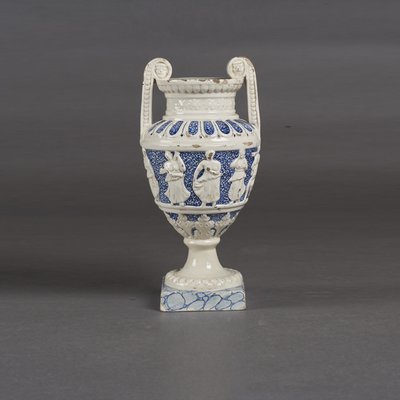
THE ART OF PROPAGANDA
Classical-style amphora, earthenware, third decade of the 1800s
(made by Fabbrica Ferrari Moreni)
The taste for a classical, almost archaeological style, made inroads into Ferrari Moreni’s production, albeit slightly later than at other manufactories.
This small amphora with reliefs, inspired by typical examples from Herculaneum, is characteristic of the neoclassical taste. Of particular note are the group of dancers within a crown and the shapes of the two handles, with reliefs and a medallion.
The penchant for archaeology recurs in many decorative ranges, showing the Sassuolo manufactory moving in the direction of an antiquarian aesthetic.
This taste was in line with late eighteenth-century fashions, and above all with the recommendations and quite possibly the will of the archducal court, which returned to Modena with the Restoration.
Archduchess Maria Beatrice Vittoria of Savoy was herself an able painter and pushed in this direction. After becoming president of the Academy of Fine Arts, she did her utmost to guide its stylistic direction.
The applied arts became a tool of propaganda for one of the most conservative governments in Italy. Similarities with the Fontebasso manufactory in Treviso, part of the Habsburg Empire, is further evidence of how Ferrari Moreni was not only a man of court but also its spokesperson.

A CANDLE AT NIGHT
Night lamp in three parts, earthenware, second quarter of the 19th century
(made by Fabbrica Ferrari Moreni)
Electricity and the comforts of modern life were yet to come – which is why this object exemplifies the beauty of past times but also embodies the spirit of an age.
This kind of night light is typical of the period from the late eighteenth to the end of the nineteenth century.
It has a dual function: as well as emitting a faint light at night, it could also be used to keep a tea or other drink warm.
It is composed of several pieces: a teapot with a lid, which is missing, a cylindrical base for the teapot and the godet, that is, a small tray where a candle or wick for oil was placed, and beneath that, an inkwell.
Typical of Ferrari Moreni’s production, this cylindrical object was inspired by models from the Fontebasso Manufactory in Treviso, which are adorned with a rich decorative repertoire of festoons, masks, tracery, painted palmettes and harpies in white and blue.
Sala 2: Il Conte Gio Ferrari e Giovanni Maria Rubbiani

PRECIOUS CUPS AND SAUCERS
Coffee cups, earthenware, second quarter of the 19th century
(made by Fabbrica Ferrari Moreni)
According to historical sources, majolica cups first emerged in the late fifteenth and early sixteenth century: these were low receptacles, their rim wider rim than their base, and came with or without a lid. When coffee arrived in Italy in the seventeenth century, it was served in cups without handles.
Only later did saucers arrive. These not only served as rests, but also to cool down the coffee. The drink was poured into the saucer and drunk from it.
This strange custom soon disappeared in favour of the cup, which became both a useful item and a vehicle of refinement and style.
We see this in these plates and cylindrical cups, which form part of elegant table services decorated with interwoven white and blue flowers, with eighteenth-century chinoiserie, neoclassical festoons or landscapes.
The cylindrical form, like the shape of the handles, was popular in both Pesaro and the Veneto.

THE TABLE BECOMES TANTALISING
Toothpick holder, earthenware, circa 1846
(made by Fabbrica Ferrari Moreni Manufacture)
Throughout Europe, the late eighteenth century ushered in major changes in table settings. Tablecloths were bedecked with new kinds of objects in porcelain and silver.
These items were initially the privilege of the wealthy but thanks to the use, firstly, of majolica and later earthenware (a supple material that’s easy to model), tableware gradually appeared in ever increasing numbers in other homes.
Secondary items such as mustard pots, spice and sugar sprinklers, cruet stands, saltshakers, knife rests and, above all, toothpick holders came into being. The toothpick is a very old instrument of oral hygiene, often made from wood or from the root of an aromatic plant.
It was Ferrari Modeni who introduced these items to the Sassuolo Manufactory. The 1846 ‘general price list’ lists ‘commedia dell’arte’ figurines in white and polychrome earthenware, described as ‘Istrice’s toothpick holder’, ‘Arlecchino’s toothpick holder’ and ‘Spagnoletto’s toothpick holder’.
Of the three on show, one is painted in polychrome and is in a different pose. The other two, also in earthenware, bear small differences due to touches made by hand before firing, even though they came from the same mould.
Similar examples can be seen in Modena’s Museo Civico d’Arte.
Room 2: The Earl Gio Ferrari and Giovanni Maria Rubbiani

AN ELABORATE BEARD
Shaving bowl, majolica, third quarter of the 19th century
(made by Fabbrica Ferrari Moreni)
In the nineteenth century, a more elaborate style of beard became widespread thanks to the emergence of more modern and less dangerous shaving instruments. At that time, long sideburns and upturned moustaches became the fashion for men.
To aid the practice of shaving, the earliest wash basins appeared along with the first steel razors and soap.
This round basin has a very wide brim and a semi-circular hollow on the edge to support the neck as one shaved.
The bowl was not designed for professional use but for everyday use, at home.
The service usually also included a jug for hot water, decorated in the same way. In this case, the decoration is a lattice or trellis and a small, repeated cross.
This ornamental motif enjoyed much success in other manufactories too. In Sassuolo, it was used widely on a range of different kinds of tableware.
Room 2: The Earl Gio Ferrari and Giovanni Maria Rubbiani

A COLUMN WITH A DANNUNZIAN FLAVOUR
Central column pot stand, majolica, last quarter of the 19th century
(Sassuolo, Fabbrica Carlo Rubbiani)
With the unification of Italy, provincial and national exhibitions emerged. Under the direction of Domenico Bagnoli initially and Carlo Casaltoli subsequently, Rubbiani products made a great leap in terms of quality and became increasingly aligned to contemporary fashions.
These products include a series of monumental furnishings in polychrome majolica inspired by Renaissance production, and tile panels decorated in a range of styles.
The tiles proved to be a great success as ceramics became part of the furnishings of every home, particularly those of the upper bourgeoisie.
One such example is this column composed of four parts, one of which (the plant stand) has been lost.
The first block (the base) is octagonal in shape, painted as lapis lazuli and adorned with a voluminous crown of flowers. This is topped by a stem-shaped trunk decorated with Raphaelesque motifs, the Rubbiani coat of arms and a garland of cherub-heads in high relief set into shields decorated with flowers and leaves.
This very complex decorative scheme is attributed to Carlo Casaltoli, who is represented by other very elegant pieces here, at Galleria Marca Corona and the Museo d’Arte di Modena.
On the upper part is an octagonal ring which covers the block upon which the last vase stood.
Even more interesting is the client: the Foresti family of Carpi were nobles but later became industrialists and important landowners. To this family was born Pietro, a well-known art collector, whose beautiful home in Carpi still stands today. This column comes from there, as noted in an inventory dated ‘1893 - A column with a large vase from the Rubbiani factory in Sassuolo. Beautiful paid 450 lire’.
Room 2: The Earl Gio Ferrari and Giovanni Maria Rubbiani

I COULD ALMOST PUT A VASE ON IT
Pair of satyr-shaped shelves, majolica, end of 1850s/beginning of 1860s
(made by Fabbrica Giovanni Maria Rubbiani)
Satyrs are mythological creatures with a human body and various animal traits, such as ears, tail, legs and sometimes goat horns.
These shelves, which are modelled and coloured, are in the shape of a satyr. In the mid-nineteenth century, such objects enjoyed considerable commercial success. These two can perhaps to be attributed to Luigi Rubbiani, third son of Giovanni Maria Rubbiani, who from 1854 owned the two ceramic factories in Sassuolo at the time.
Luigi graduated with honours in modelling and sculpture from the Atestina Academy of Fine Arts in Modena. He produced various objects inspired by the eclectic and historicist taste typical of this transition period of the United Italy, which were highly appreciated and in demand, both critically and commercially. They recall the sumptuous Renaissance ceramics that brought such success and fame to Italian majolica.
Luigi died prematurely and left a large family, which was adopted by his uncle Antonio. The business then passed to Domenico Bagnoli from Correggio, who became director of the Fabbrica Vecchia.
Room 2: The Earl Gio Ferrari and Giovanni Maria Rubbiani

CERAMICS IN EVERYDAY LIFE
Centrepiece in the shape of a bag (or ‘basket’), maybe for holding newspapers, earthenware, last quarter of the 19th century
(made by Fabbrica Rubbiani)
Eager to offer an ever-richer selection of ceramic objects, the Rubbiani expanded their production of furnishings and decorations for the home.
They produced objects and trinkets for all budgets, be they centrepieces or ornaments, and were alert to the tastes of the period, which can strike us as kitsch.
This basket is one such product. It is perhaps a newspaper holder shaped as a bag, inspired by the most popular and widespread examples in the Modena area at that time: Carpi basketry. These were elegant and elaborate items, above all the hats, which rivalled the straw hats made in Florence.
The art of basketry emerged in Carpi in the sixteenth century and consists of extracting thin strands - shavings – of the same thickness, length and width from the trunks of willow and poplar trees.
Mechanisation made it possible to massively increase this type of production: once the long strands were woven, they could be used for hats, bags and more.
The success of the hats - light, cheap, waterproof and useful for providing shade from the heat of the Po Valley – also reached beyond Italy thanks to the National and International Exhibitions. The factories could be run cheaply, which, after the war, became an all-important factor in launching the area’s textile industry.
Room 2: The Earl Gio Ferrari and Giovanni Maria Rubbiani

UNITY IS STRENGTH
Large ornamental vase, majolica and earthenware (handles), 1880s
(made by Fabbrica Carlo Rubbiani)
By the 1880s, the production of ceramics found new impetus.
The Carlo Rubbiani Manufactory invited talented and experienced modellers and painters to work with them, who signed pieces as authored works.
This vase represents the rich production of that period, which saw a collaboration between the Modenese modeller/painter Silvestro Barberini and the Florentine painter Carlo Casaltoli.
Barberini, who trained at Modena’s Academy of Fine Arts and was responsible for the vase’s handles, arrived at the Rubbiani Manufactory around 1885, shortly after Casaltoli arrived in Sassuolo.
Together they produced some of Sassuolo’s best and most monumental objects of that time, very much in line with prevailing fashions and taste.
It is no coincidence that Casaltoli would also become a successful advertising designer and Barberini, one of the most sought-after sculptors in late nineteenth-century Emilia.
Room 2: The Earl Gio Ferrari and Giovanni Maria Rubbiani

THE ARRIVAL OF THE TILE AND THE SASSUOLO DISTRICT
Plaques and wall tiles, majolica, end of the 19th century/first quarter of the 20th century
(Fabbrica Carlo Rubbiani and others)
The first tile was created in Wedgwood, England, around 1840, when Richard Prosser patented the dry pressing method which reduces both drying times and the risk of deformations during firing.
In 1891, when Carlo Rubbiani died, the Sassuolo factory was at the forefront of the industrial production of majolica tiles. Already technically advanced through their production of road signs, the Rubbiani then acquired and used tile technology. As a decorative element, tiles covered large surfaces in imitation of the ceramicists of the past, as seen in the panels still at Galleria Marca Corona and the Rubbiani Tomb in the cemetery of San Prospero in Sassuolo.
The Sassolese tile was probably first shown at the Bologna Exhibition of 1888 and, more significantly, the National Exhibition of Ceramic and Glass Art at Rome’s Museo Artistico Industriale in 1889. Here the Rubbiani’s ‘essay of majolica tiles’ for floors and walls were shown instead of the usual vases and furnishings, sparking a certain distrust among other exhibitors but great curiosity among visitors.
The transition towards industrial tile production required a great economic push, which led to the original administrative structure being dissolved. However, the Rubbiani’s experience became a forerunner to the birth and development of other factories in the region, which continue to produce tiles today.



